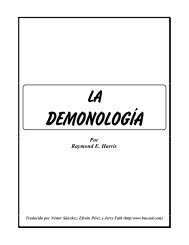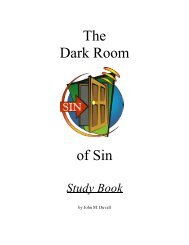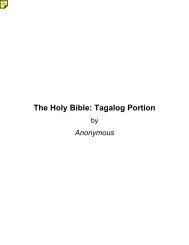Thematic Studies In Bible Basics Lesson 1 - Bible Study Guides
Thematic Studies In Bible Basics Lesson 1 - Bible Study Guides
Thematic Studies In Bible Basics Lesson 1 - Bible Study Guides
Create successful ePaper yourself
Turn your PDF publications into a flip-book with our unique Google optimized e-Paper software.
First Principles Of The Oracles Of God<br />
<strong>Lesson</strong> 3<br />
The Lutheran Church<br />
Est. 1530 A.D. in Germany<br />
Founder: Martin Luther & followers<br />
The Presbyterian Church<br />
Est. 1540 A.D. in Switzerland<br />
Founder: John Calvin<br />
The Protestant Episcopal Church<br />
Est. 1578 A.D. in California<br />
Founder: Francis Drake<br />
The Baptist Church<br />
Est. 1607 A.D. in England<br />
Founder: John Smyth<br />
The Methodist Church<br />
Est. 1729 A.D. in England<br />
Founders: John & Charles Wesley<br />
Oldest of “Protestant” churches (those who protested Catholicism). Luther<br />
was a Catholic priest who grew weary of corrupt practices such as the<br />
selling of indulgences and the wicked lifestyles of priests. He sought to<br />
reform the Catholic Church, not start another one. However, after the<br />
Catholic Church excommunicated him, his followers used his published<br />
catechisms to eventually begin the church that now bears his name.<br />
Calvin became influenced by Luther’s writings, as well as those of an<br />
ancient 4th century theologian name Augustine. Given Calvin’s desire for<br />
strict governance in the churches, his followers eventually adopted the<br />
name “Presbyterian” most likely because of 1 Tim. 4:14, a reference to<br />
the presbytery (eldership). Entire identity of the church centers around its<br />
government. Each “presbytery” contains several churches.<br />
This is the American version of the the Church of England, founded by<br />
King Henry VIII in 1534. He revolted against the Catholic Church when the<br />
pope refused to let him divorce his wife and marry someone else. This<br />
began the “state church” of England. The first Anglican service conducted<br />
on this continent was led by Francis Drake in 1578. Eventually, this church<br />
immigrated through the colonies, almost being destroyed in the American<br />
Revolution (her priests were still loyal to the British crown). <strong>In</strong> 1783, it<br />
began using its present-day name.<br />
Smyth was in the clergy of the Church of England and a member of the<br />
English Separatists (believers in the separation of church and state). He<br />
opposed the Church of England with the King as head of the church. He<br />
rejected infant baptism and believed, among other things, solely in<br />
immersion; thus, the name “Baptists” began being used by his followers.<br />
Sons of a Church of England clergyman, the Wesleys opposed the rigid,<br />
cold, and indifferent conditions of the Church of England. They began<br />
meeting with small groups which became increasingly popular. They held<br />
to strict methods of study, diet, exercise, etc. Outsiders eventually began<br />
calling them the “Methodists.”<br />
9















